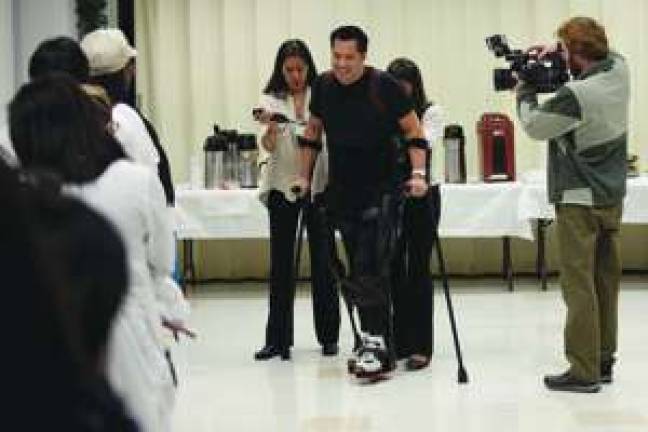Bionics Rehab Program Opens at Mount Sinai

"Am I going to walk again?" That is the question Robert Woo asked Dr. Kristjan Ragnarsson in 2007 after a crane collapsed 25 stories above the ground and spilled 30 pounds of steel tubes on him. Woo was an architect hired by Goldman Sachs at the time, working on the construction of their global headquarters downtown. He was a new father of two boys, and at 39 years old, was just entering the peak of his career. Ragnarsson, the chairman of the Department of Rehabilitation Medicine at Mount Sinai Medical Center, answered Woo with the same response he has given most of his patients over his 41-year career as an internationally renowned doctor dealing with spinal cord injuries. "It's possible," he said. "But the chances are small." On Dec. 6, however, Woo took a very literal step toward beating the odds. Mount Sinai's Department of Rehabilitation Medicine, in the Klingenstein Clinical Center at 1450 Madison Ave., celebrated the opening of its Rehabilitation Bionics Program with a demonstration of a battery-powered exoskeleton that allows paralyzed users to walk. The device is called the Ekso, and Woo was chosen to give it a spin for a small gathering of friends and sponsors. Woo has been strapped into the machine many times before. For the past year, he has trained with it three times a week in sessions that last up to two hours. The device looks like the lower half of a human skeleton, with a spinal cord and jet pack attached. The current model, still a fairly early prototype by developer Ekso Bionics, requires the assistance of two physical therapists to stabilize the walker and to operate the leg controls. They fussed with the device as Woo ambled from one end of the room to the other, but they did not dampen his enthusiasm for the device. "Standing here today and talking to you eye to eye, instead of looking up to people and being looked down on, it makes you realize what you take for granted," he said in a short speech. "Only when you lose it, and your entire world changes, you realize that even the smallest thing can make a huge difference in how we see ourselves and how others see us." Woo catalogued the numerous and unexpected health improvements he has experienced from his training sessions, including fewer muscles spasms and better digestion and bladder control, in addition to greater physical strength. About three months ago, he felt hunger for the first time since his injury. "I'm getting things back. My quality of life has just soared," he said. "When I get the chance to stand up, I just don't want to stop. There are times when the therapists say the session is almost up, and I say, 'Okay, one more round, one more round.' " Three other wheelchair-bound users of the machine, including Chris Tagatac, an ambassador for Ekso Bionics, avowed the same health benefits, both physical and psychological. "When I look at this device, I see a device that helps us get connected again," said Tagatac. "It connects us physically-we feel our feet again on the ground. It connects us eye to eye with the world, which is priceless in my mind." The Ekso developed out of a military program that designed powered leg braces for soldiers to help with heavy lifting. According to Dr. Ragnarsson, many models of walking machines had been created before the military's funding-models composed of everything from steel to inflatable fabrics-but all failed because they could not provide the right mix of power and balance, and required too much energy. "Now, we have technology that is totally different," Ragnarsson said. With the opening of the Rehabilitation Bionics Program, the Department of Rehabilitation Medicine aims to test the limits of this technology to prove its benefits and determine its marketability. "There are lots of different potential advantages to these technologies. They can help with fitness, they can help with mobility and there may even be the possibility that they can encourage neurological recovery," said Jeanne Zanca, assistant professor in the department. "But all of these things are hunches. We need to put some data behind them so that we can aid the development of these technologies and we can back up how they should be used to improve the health and quality of life of individuals." Woo is optimistic about the Ekso's progress. "One day, the device will be so small that I can wear my clothes over it," he said. "I can walk down the street. I can push my children to the park. I can stand up next to my wife to give her a hug. I could do so many things."